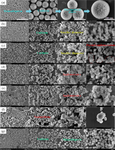Journal of Porous Materials ( IF 2.6 ) Pub Date : 2024-04-12 , DOI: 10.1007/s10934-024-01595-8 Yue Shu , Jianghui Tao , Yanni Wang , Liangzhu Huang , Yabin B. Wang

|
In comparison with traditional mesoporous materials, dendritic mesoporous silica&titania nanospheres (DMSTNs) with three-dimensional central radial pore channels and multiscale pores have larger pore volume, higher specific surface area, and easier accessible surfaces, making them promising carrier platforms for the applications in catalysis, drug delivery, heavy metals adsorption, etc. In this study, DMSTNs have been manufactured by a one-pot co-condensation method using titanium(diisopropoxide)bis(2,4-pentanedionate) (TDA) as the titanium source. Their morphologies and structures have been finely tuned by TDA content, reaction temperature, stirring rate, solvents, and so forth. Scanning electron microscopy (SEM) and transmission electron microscopy (TEM) have been utilized to directly reveal their differences. Two typical kinds of DMSTNs synthesized at different temperatures have been compared, covering N2 adsorption-desorption isotherms, X-ray photoelectron spectroscopy (XPS), Raman spectrum, ultraviolet-visible diffuse reflectance spectroscopy (UV-Vis-DRS), Fourier Transform Infrared spectroscopy (FT-IR), etc. XPS and Raman results testify that the chemical composition and architecture of these DMSTNs resemble those of titanium silicalite-1 (TS-1) zeolite. The hydrogen yield and the corresponding rate of DMSTNs synthesized at 120 ℃ are 3.56 µmol·g-1 and 0.71 µmol·g-1·h-1, being about 2.99 times higher than those of DMSNs that solely own SiO2 in the skeleton. Nevertheless, DMSTNs synthesized at 70 ℃ possess a 10.08 µmol·g-1 yield and a 2.04 µmol·g-1·h-1 rate, nearly 8.47 times higher than those of DMSNs.
中文翻译:

树枝状介孔二氧化硅和二氧化钛纳米球的简便合成和精细形貌调控
与传统介孔材料相比,具有三维中心径向孔道和多尺度孔道的树枝状介孔二氧化硅和二氧化钛纳米球(DMSTN)具有更大的孔体积、更高的比表面积和更容易接触的表面,使其成为催化应用的有前途的载体平台、药物输送、重金属吸附等。本研究以二异丙醇钛双(2,4-戊二酮)(TDA)为钛源,通过一锅共缩合法制备了DMSTN。它们的形态和结构已通过 TDA 含量、反应温度、搅拌速率、溶剂等进行了微调。扫描电子显微镜(SEM)和透射电子显微镜(TEM)已被用来直接揭示它们的差异。比较了不同温度下合成的两种典型的DMSTN,涵盖N 2吸附-脱附等温线、X射线光电子能谱(XPS)、拉曼光谱、紫外-可见漫反射光谱(UV-Vis-DRS)、傅里叶变换红外光谱XPS 和拉曼结果证明这些 DMSTN 的化学成分和结构与钛硅沸石-1 (TS-1) 沸石相似。 120 ℃下合成的DMSTNs的氢产率和相应速率分别为3.56 µmol·g -1和0.71 µmol·g -1 ·h -1 ,比骨架中仅含有SiO 2的DMSNs高约2.99倍。然而,在70 ℃下合成的DMSTNs具有10.08 µmol·g -1的产率和2.04 µmol·g -1 ·h -1的速率,比DMSNs高出近8.47倍。



























 京公网安备 11010802027423号
京公网安备 11010802027423号